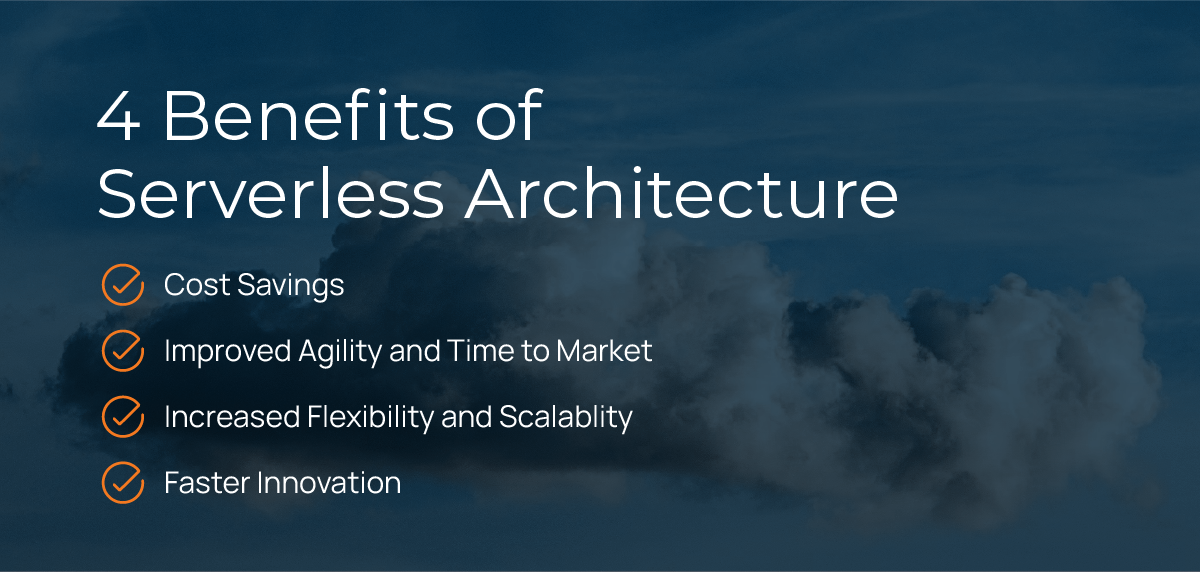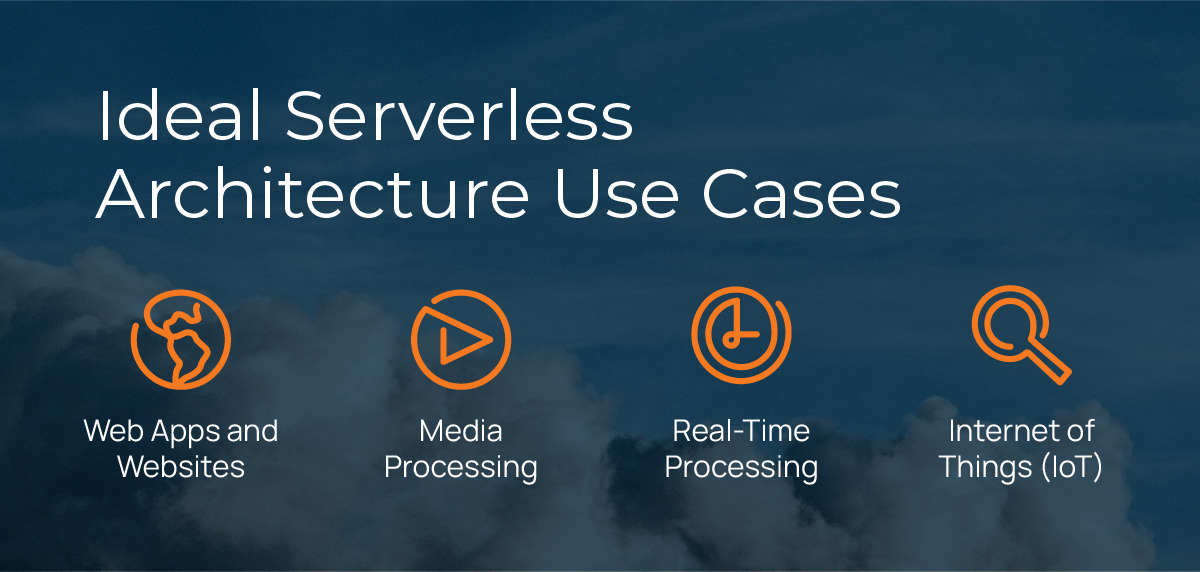Blog
What Are the Economic Advantages of the Cloud?
The good news for IT is that, by using serverless architecture, you can lower your IT spend while receiving comparable computing capabilities and performance. So, what's serverless architecture, and what are the economic advantages of the cloud?
In short, serverless architecture is a way to design applications and services without having to manage infrastructure. Going this route can have a major impact on the cost-effectiveness of your business. The economic benefits of serverless computing free up additional funds you can reinvest into your business or use to safeguard your financial security during challenging times. With the right planning and tools in place, you can migrate to Amazon Web Services (AWS) serverless architecture without having to compromise efficiency for the sake of reducing costs.
Learn more about serverless architecture, its applications for your business, the most common benefits, and how to adopt AWS serverless architecture.
What Is Serverless Architecture?
Serverless architecture is a cloud-computing software design solution where a third party hosts applications or code running on compute resources that are abstracted away from the user. Basically, it’s a way to build and run applications while significantly reducing your infrastructure administration overhead, as your cloud provider handles tasks such as the provisioning, scaling, and, maintenance of the server infrastructure.
Going serverless means that developers can focus directly on uploading their code and running it in a fully managed environment. You don’t have to worry about provisioning and managing servers. Adopting serverless architecture can create cost savings and flexibility, as you’re only paying for the resources you use and not worrying about server capacity planning or scaling.
If you’re thinking of migrating, AWS offers some of the most advanced serverless solutions on the market. AWS also provides ample computing power to handle all your workloads and the ability to scale with real-time demand. AWS automates a variety of tasks, giving you more time to concentrate on your business goals and improve your ROI.
4 Benefits of Serverless Architecture
Serverless platforms eliminate the need for traditional computing services. With serverless, developers can build and run code in small, modular pieces. This makes it easier to make changes and iterate quickly. Because infrastructure is fully managed, your IT team can focus on continuing to build cutting-edge products or business-critical tasks rather than spending time on maintenance and provisioning.
Serverless provides numerous benefits for companies without sacrificing service for customers. Read on for more information on the most common benefits.

Cost Savings
Because you’re charged based on actual usage, serverless architecture can improve your cost-effectiveness. Not only does AWS make it easy to reduce your expenses, but it also offers convenient visibility of your usage and billing details. You can see how many requests were made to an API gateway endpoint or how many seconds (or milliseconds) it took for a function to execute. The bottom line: You don’t have to anticipate the resources you’ll need or when you’ll need them.
You’ll also save on costs associated with internal architecture administration, such as server and database management, as you’re essentially outsourcing these responsibilities. Because you won’t need to scale or overprovision infrastructure to accommodate increased loads, you’ll save money on administrative overhead.
Yet another area where you can save money is on server costs, as you only need to pay for the resources you use rather than being billed for idle capacity.
Improved Agility and Time to Market
Serverless functions use cloud resources more efficiently while loading and executing faster than monolithic applications, thus improving performance. Serverless architecture removes the need for time-consuming tasks such as managing and maintaining servers.
Serverless architecture saves on server costs and makes your applications more scalable and easier to manage. There’s no need to worry about server provisioning or capacity planning. You can also deploy updates faster and more efficiently.
When you adopt a serverless architecture, you can use microservices that allow independent development and deployment of different parts of applications. Not only can these processes improve agility and time to market, but they also make it easier to scale application elements as needed.
Increased Flexibility and Scalability
One benefit of cloud computing is that serverless functions can be chained together, resulting in highly flexible, efficient processes. Serverless architecture can also scale automatically, meaning there’s no need to provide infrastructure based on demand estimations. Instead, you can deploy faster and scale more easily without infrastructure constraints.
Faster Innovation
Going serverless means your development team doesn’t have to worry about server and infrastructure overhead planning and management. Instead, they can focus on iteratively building and launching more features and products. The agile nature of serverless architecture provides more significant opportunities for rapid experimentation and deployment, quicker responses, and accelerated innovation.
Drawbacks to AWS Serverless Architecture
While AWS serverless architecture has many benefits, it’s not the best solution for every business. There are a few potential drawbacks to serverless architecture. For example, because your application is running on a third-party platform, you have less control and are more reliant on the provider than you would be if you managed your own servers.
Another potential challenge is increased latency because your code is running on a remote platform. This can create issues for certain types of applications. Additionally, if you have a high-traffic application, costs can quickly add up because serverless applications can be more expensive than other options.
If your organization faces any of the challenges below, you’ll likely need to find an alternative solution.
Long-Running Compute Tasks
While AWS Lambda has increased its maximum run time to 15 minutes, it’s still more efficient to run intensive tasks on traditional compute resources.
Performance SLAs
If you have strict performance service-level agreements (SLAs) with your customers, serverless might not be the best fit. Results may vary, making your ability to meet SLAs inconsistent.
Inapplicable Use Cases
Not every workload is suitable for serverless. Unless a workload was developed with serverless in mind, you may need to spend valuable time, resources, and expenses towards re-architecting workloads to make them fit within a serverless framework.
Vendor Lock
Depending on the services used, your serverless workload may not be portable if you decide to change cloud services.
On-Premises Requirements
One of the cloud’s most significant advantages for businesses is removing the complexity of on-site management. However, this shift also means you’ll give up control over certain decisions, such as how data is stored. Public cloud options might not be viable for businesses that require access to hardware, such as those with regulatory or security requirements.
Serverless Architecture Use Cases
Before implementing serverless architecture, it’s important to consider your current needs as well as any future requirements of your application. For example, serverless architecture may be well-suited for a social media app that allows users to create profiles, share content, and interact with others. However, it may not be able to meet the demands of a high-performance, low-latency application, such as a real-time game application. Here are use cases for AWS serverless architecture that can help you get the most value from your investment.
Web Apps and Websites
Dedicating a server for the sole purpose of hosting your web apps and websites is an outdated, time-consuming practice. Go serverless to get all the availability, performance, and functionality you need without managing a single server.
Media Processing
Serverless architecture can process large volumes of media files without the problems of legacy technology, which include software crashes, resource allocation, and full hard drives.
Real-Time Processing
Serverless architecture is also ideal for time-sensitive workloads. Serverless means you can process real-time data, such as streaming data, with just as much security, flexibility, and cost savings in the cloud as when processing batch data.
Internet of Things
An internet of things (IoT) platform must be reliable, flexible, and cost-efficient. AWS serverless architecture is an ideal choice for all three conditions, along with benefits such as supporting MQ telemetry transport, one of the most prevalent IoT communication protocols.

How to Adopt AWS Serverless Architecture
Once you’ve determined that your use cases are a good fit, you can begin developing and implementing a serverless strategy that meets your business needs.
1. Evaluate Your Workloads and Needs
Before you start developing and implementing a serverless strategy, it’s important to evaluate your workloads to understand what’s needed to support serverless architecture. Making such support possible might involve adapting existing applications or creating new ones.
2. Use Support Tools and Services
Look for tools and services best suited to your cloud operations needs. AWS offers tools such as AWS Lambda, Amazon API Gateway, and Amazon DynamoDB to help you implement serverless architecture. It’s important to look for the tools and services that are best suited to your business needs.
3. Develop Your Strategy
When developing your serverless strategy, it’s crucial to consider how you'll handle events, state, security, monitoring, and logging. Each of these areas presents unique challenges.
For example, when using AWS Lambda, it’s important to be aware of its limitations, such as the maximum execution time and memory usage. Additionally, you’ll need to design your Lambda functions to be idempotent so they can safely be run multiple times in case of an error.
4. Build and Test Your Application
It’s critical that you test and validate your application before moving to production. This ensures that everything is working as expected and gives you an opportunity to review elements such as load and security testing.
5. Analyze and Optimize
While the initial development of a serverless application is relatively simple, ongoing management and maintenance can be more complex. It’s important to monitor the usage and performance of your application and maintain a focus on cost optimization. As your business evolves, so should your application.
Creating Paths for New Opportunities
Developing a serverless strategy can be a complex undertaking, but the potential rewards are significant. A well-executed serverless architecture can improve scalability, reliability, and cost-efficiency.
If your business is searching for a way to lower costs, adopting AWS serverless architecture can greatly lower your IT spend. Businesses increasingly realize that serverless architecture is essential for answering the question “What are the economic advantages of the cloud?” Beyond the obvious cost savings, serverless architecture improves IT efficiency and adaptability while creating opportunities for innovation.
Adopting an AWS serverless architecture also means there are a variety of opportunities to further optimize your costs. Find out how Mission, an AWS Premier Tier Services Partner, can help you reduce your AWS costs by up to 5% today.
Author Spotlight:
Brian Yung
Keep Up To Date With AWS News
Stay up to date with the latest AWS services, latest architecture, cloud-native solutions and more.

